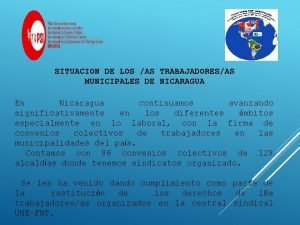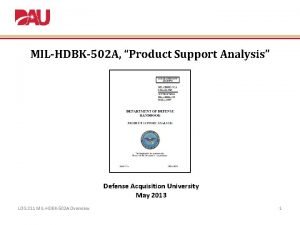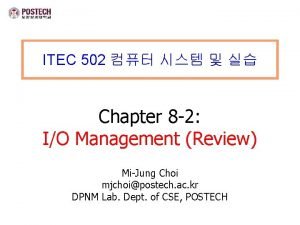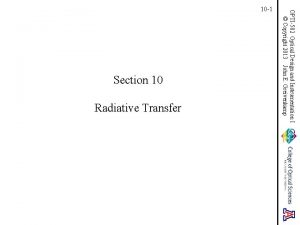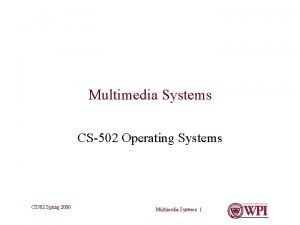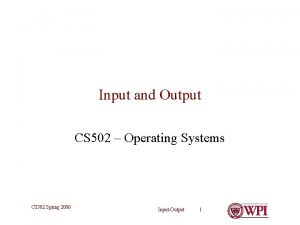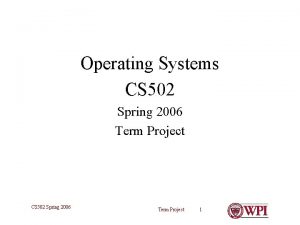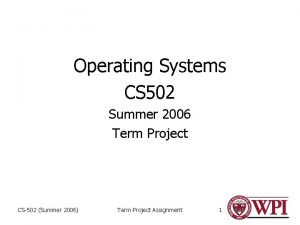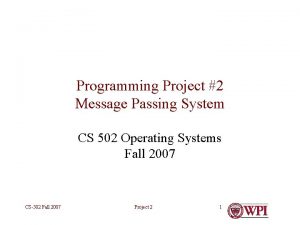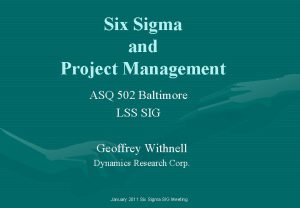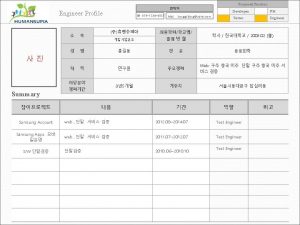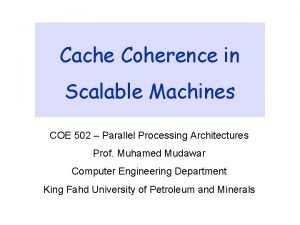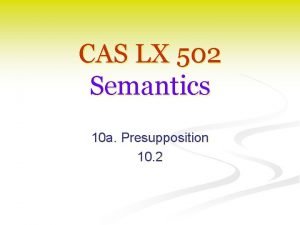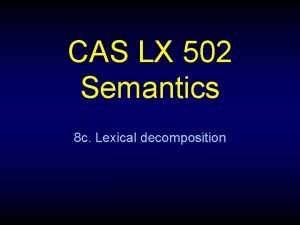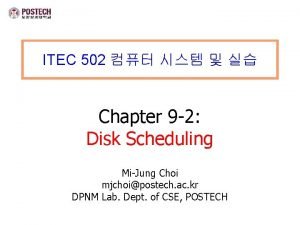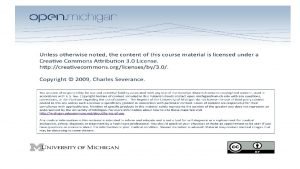The OS 502 Project OS 502 Project Outline










![Interruption Causes • Use STAT_VECTOR[SV_VALUE][x] to determine an interruption cause and influence processing: – Interruption Causes • Use STAT_VECTOR[SV_VALUE][x] to determine an interruption cause and influence processing: –](https://slidetodoc.com/presentation_image_h2/c663a051a80661da836579fe3afb1e1a/image-11.jpg)




- Slides: 15

The OS 502 Project

OS 502 Project Outline • • Architecture of the Simulator Environment Z 502 Hardware Organization and Architecture Generic Operating System Structure The Test Suite – Phase 1 Tests – Phase 2 Tests 2

Simulator Environment OS 502 Test Suite (test. c) test 0 test 1 a test 1 b test 1 x test 2 a OS 502 Operating System (base. c, scheduler_printer. c) Z 502 Hardware Simulator (z 502. c) test 2 b . . . All elements inside the heavy box are in a single process, running a single thread of execution. All I/O devices of the Z 502 are simulated entities. This includes the timer device and the disk devices. Try to treat the Z 502 Hardware Simulator as a “black box” and use the Z 502 architecture specification instead. Native Operating System (Windows NT, HP-UX, Solaris, etc. ) Native Hardware Platform (IA-32, PA-RISC, Sun Workstation, etc. ) 3

Z 502 Architecture • Dual-Mode architecture – User mode (see A. 4) • High level language, augmented with – Z 502 General Purpose Registers – Macros for simplifying reentrant programs – Systems Calls, provided as macros (do not rewrite!) • Z 502 “Programs” are written as C functions taking a void parameter and having a void return. • Example Program: void test 0( void ) { } SELECT_STEP { STEP( 0 ) printf(“This is test 0”); GET_TIME_OF_DAY( &Z 502_REG_1 ); STEP( 1 ) printf(“Time of day is %dn”, Z 502_REG_1); TERMINATE_PROCESS( -1, &Z 502_REG_9 ); STEP( 2 ) printf(“Error: Test should be terminated, but isn’tn”); break; } 4

Z 502 Architecture (cont. ) – User Mode (cont. ) • Address space for user programs is divided into – C code “program” memory for instructions and for local variables. This, for all intents and purposes, is not constrained in size. – User “data” memory, referenced through a virtual address space, and called MEMORY, and accessed from user space through the MEM_XXXX macros. No programs in phase 1 access this user memory. – Kernel Mode • Instruction set includes C language instructions, plus – access to all the Z 502 registers – access to Z 502 physical memory (MEMORY) – access to the privileged instructions of the Z 502 instruction set • I/O primitives • memory primitives • context switching primitives – These are all available through provided macros 5

Z 502 Registers and Vectors 6

Interruption Handling by the Z 502 • Interruption Sources – Interrupts • TIMER_INTERRUPT from the delay timer • DISK_INTERRUPT from disk 1, 2, . . . – Faults • INVALID_MEMORY fault • CPU_ERROR fault • PRIVILEGED_INSTRUCTION fault – Traps • SOFTWARE_TRAP for each system call – TO_VECTOR contains an address for each category of interruption source. 7

Interruption Handling • In os_init (the OS boot code), the OS sets values for each of the entries in TO_VECTOR. • On the Z 502, there is a total enumeration of all interruptions (exceptions) • • • SOFTWARE_TRAP CPU_ERROR INVALID_MEMORY PRIVILEGED_INSTRUCTION TIMER_INTERRUPT DISK_INTERRUPT + 1 … LARGEST_STAT_VECTOR_INDEX 8

Z 502 Hardware Actions on Interruption • Let the interruption number (called exception in Appendix A) be x. • User registers are saved in Z 502 Hardware Context • Hardware sets – STAT_VECTOR[SV_ACTIVE][x] = TRUE – STAT_VECTOR[SV_VALUE][x] = interruption specific info • Execution mode is set to kernel • Hardware begins execution at Interrupt, Fault, or Trap entry point as defined by TO_VECTOR • Note that INTERRUPT_MASK is not set to TRUE. The operating system must do this if that is the desired mode of operation. 9

OS Responsibilities on an Interruption • On Entry – Mask interrupts (if desired) – Clear the Interruption Source • set STAT_VECTOR[SV_ACTIVE][x] to FALSE – Determine the cause of the interruption and process accordingly • On Exit – Unmask interrupts (if not already done). – For Interrupts, simply return – For traps and faults, ultimately exit the OS by performing a context switch (even if that switches back to the original process). This operation restores the user registers from the Z 502 Hardware Context and sets the execution mode back to user. 10
![Interruption Causes Use STATVECTORSVVALUEx to determine an interruption cause and influence processing Interruption Causes • Use STAT_VECTOR[SV_VALUE][x] to determine an interruption cause and influence processing: –](https://slidetodoc.com/presentation_image_h2/c663a051a80661da836579fe3afb1e1a/image-11.jpg)
Interruption Causes • Use STAT_VECTOR[SV_VALUE][x] to determine an interruption cause and influence processing: – For SOFTWARE_TRAP, value is the system call number. Use this to enter a switch statement to process system calls. – For CPU_ERROR, value is given by error codes (see table in Appendix A) – For INVALID_MEMORY, value is virtual memory page causing the fault – For PRIVILEGED_INSTRUCTION, value is 0 – For all interrupts (timer and disk), value is given by error codes (where one of the possibilities is ERR_SUCCESS) 11

Z 502 Hardware Context • The context is the state of the executing CPU, essentially its registers. • The Hardware context is essentially a register set, plus an entry address. • The OS only deals with the handle to a context. Typically this is stored in the process control block. • Z 502 Operations for manipulating contexts – Z 502_MAKE_CONTEXT(handle, start address, kernel flag) – Z 502_DESTROY_CONTEXT(handle) – Z 502_SWITCH_CONTEXT(save/destroy flag, handle) 12

Operating System Structure • Organize into functional areas – What are the functional areas of the Operating System? – What are the abstract data types required? – Class participation, putting together an OS structure… • Next steps (Milestone 3) – Strawman functional spec for each module defined in the block diagram. – For each module • set of interrelations with other OS modules • portions of the Z 502 interface being invoked by the module • Set of system calls realized within the module – For system calls • Categorization by module • Attributes: blocking vs. non-blocking, save/destroy context 13

Milestone 4: test 0 • Code given previously. Nearly the simplest user program possible. • Requirements – Core OS • os_init – TO_VECTOR • trap_handler – System call switch – Process Management module • os_create • os_terminate – Timer module • os_get_time 14

The Test Suite: Phase 1 • Test 1 a: Add SLEEP, requires timer multiplexing and interrupt handling, infrastructure for multiple processes. • Test 1 b: Interface tests to CREATE_PROCESS • Test 1 c: Multiple instances of test 1 a; demonstration of FCFS scheduling (by using same priorities) • Test 1 d: Likewise for different priorities • Test 1 e: Suspend/Resume interface test • Test 1 f: Suspend/Resume on real scheduling • Test 1 g: Change Priority interface test • Test 1 h: Change Priority on real scheduling • Test 1 k: Misc. error tests 15
 Ley 502 nicaragua
Ley 502 nicaragua Single family housing section 504 repair pilot program
Single family housing section 504 repair pilot program 5776-855
5776-855 Product support analysis psa
Product support analysis psa Problem set one episode 502 answer key electron dot diagram
Problem set one episode 502 answer key electron dot diagram Mgt502 business communication
Mgt502 business communication Krs156.502
Krs156.502 Kernel io subsystem
Kernel io subsystem 502
502 Krs156.502
Krs156.502 502-026-050
502-026-050 Opti 502
Opti 502 Ceip los almendros rivas
Ceip los almendros rivas Cs 502
Cs 502 502
502 Quote one topic sentence
Quote one topic sentence
